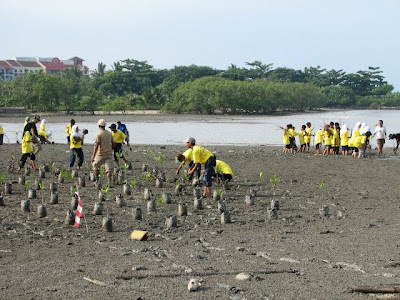In December 2010, I took a researcher from UKM to the mangroves planting site at Kuala Melaka and Kuala Teriang to assess the area. After all my nine times of planting the Rhizophora saplings there, it is not a surprise that most of the 90% of the seedlings planted by us and other groups were all GONE...
All wiped out!
Let's go back in time. Back then, a planting project sponsored by Digi program in August 2007...

Another group planted at Vanessa's backyard. The group and the date of planting is unknown.

A YouTube Video by Vanessa - Thanks for this!
Another unknown group planted hundreds or if not, almost thousands of seedlings on the coastline of Kuala Melaka and Kuala Teriang in May 2010


And our little planting project-cum-experiment with my group of friends from year 2009 to 2010...





Let's look at how the soil condition of this area can do a 180 degree change!
From very muddy:

Aida in the mud... back in April 2009

Wet, wet,wet in April 2010
...to desert:

Desert in January 2010

And the changes in the population of saplings:
We wanted to test a small plot and so Aida speared a marker into the ground

January 2010: Our marker was still there after a month
Our marker in May 2010
Our marker in June 2010
Our marker was still standing after most of its "friends" (young Rhizophora saplings) were all washed away. Can you see the marker? It has somehow got further into the ground. I didn't push it in, I swear! Accumulation of mud to be blamed?
After all of our efforts and amateur strategies, I decided that these spots are impossible to start a healthy mangrove forest due to the wave actions, soil instability and the huge amount of big trash that came in during the South-West monsoon. Unless a wave breaker structure is built at the front, which will be an expensive project; otherwise, any future planting projects would be futile.
Both researchers that I know suggested to plant Avicennia saplings instead of Rhizophora as they are the front liners. I must agree that Avicennia genus of mangroves flora is indeed quite hardy. However, the seeds are difficult to collect. Hmm... another project?

The recent earthquake in Japan has created a strong and devastating tsunami. From the videos I have seen on how the waves destroyed the cities and if the mangrove forest are there, I would imagined that they will be eventually be flatten. (MK, you were right) My deepest condolences to Japan who had lost many lives in the tsunami.
Click here for all the posts on our planting.
Click here for all the posts on our planting.










Hi WChinner,
ReplyDeleteMy deep condolences to the Japan as well...
I agree with you that planting pioneering species (Avicennia spp.) on the shoreline is a way to go.
After they have succeeded in establishing themselves in the mud, subsequent succession should occur naturally by way of beach debris bringing mangrove seedlings eg: Rhizophra spp. onto the shoreline.
By this time, the ground will be stable enough to support more emerging succession of mangrove species. Eventually, this will develop into a full-fledged mangrove forest, but I must stress it will take decades to reach that level, though...
All the best with your mangrove project! :)
Jiayou Jiayou~
ReplyDeleteTrial and error is the scientist's way to get the wanted result, must keeep trying!
Hope to join in one of your projects if I get the chance :-)
Hi JK,
ReplyDeleteThank you. As for the full-fledged mangrove forest, I will not live to see it...hahhhaha
Hi Raoul,
That was my childhood dream.. to become a scientist. But I got diverted somehow.
You are always welcome here.